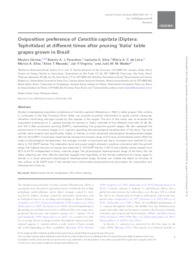Oviposition preference of Ceratitis capitata (Diptera: Tephritidae) at different times after pruning Italia table grapes grown in Brazil.
Oviposition preference of Ceratitis capitata (Diptera: Tephritidae) at different times after pruning Italia table grapes grown in Brazil.
Author(s): GÓMEZ, M.; PARANHOS, B. A. J.; SILVA, J. G.; LIMA, M. A. C. de; SILVA, M. A.; MACEDO, A. T.; VIRGINIO, J. F.; WALDER, J. M. M.
Summary: Studies investigating oviposition preference of Ceratitis capitata (Wiedemann, 1824) in table grapes (Vitis vinifera L.) cultivated in the São Francisco River Valley can provide important information to guide control measures, therefore minimizing damage caused by this species in the region. The aim of this study was to evaluate the oviposition preference of C. capitata females for berries cv. ?Italia? collected at five different times (60, 70, 80, 90, and 100 d after production pruning [DAPP]), representing five grapevine growth stages. We also assessed the performance of immature stages of C. capitata regarding the physiological development of the berry. The total soluble solid content was significantly higher in berries at more advanced physiological developmental stages (90 and 100 DAPP). Conversely, these berries showed the lowest values of firmness and titratable acidity. With the onset of physiological development, the average number of punctures per berry increased and reached 5.2 per berry in 100 DAPP berries. The infestation level and pupal weight showed a positive correlation with the growth stage. The highest recovery of pupae was observed in 100 DAPP berries (1.54). Pupal viability values ranged from 50.9 to 64.7% independent of berry maturity stage. The physiological developmental stage of the berry did not affect offspring sex ratio. Results obtained suggest that regardless of the female preference for laying eggs on berries in a more advanced physiological developmental stage, females can initiate the attack to bunches of this cultivar at 60 DAPP, even if the berries have unfavorable physicochemical parameters for oviposition and development of larvae.
Publication year: 2019
Types of publication: Journal article
Unit: Embrapa Semi-arid Region
Observation
Some of Embrapa's publications are published as ePub files. To read them, use or download one of the following free software options to your computer or mobile device. Android: Google Play Books; IOS: iBooks; Windows and Linux: Calibre.
Access other publications
Access the Agricultural Research Database (BDPA) to consult Embrapa's full library collection and records.
Visit Embrapa Bookstore to purchase books and other publications sold by Embrapa.

